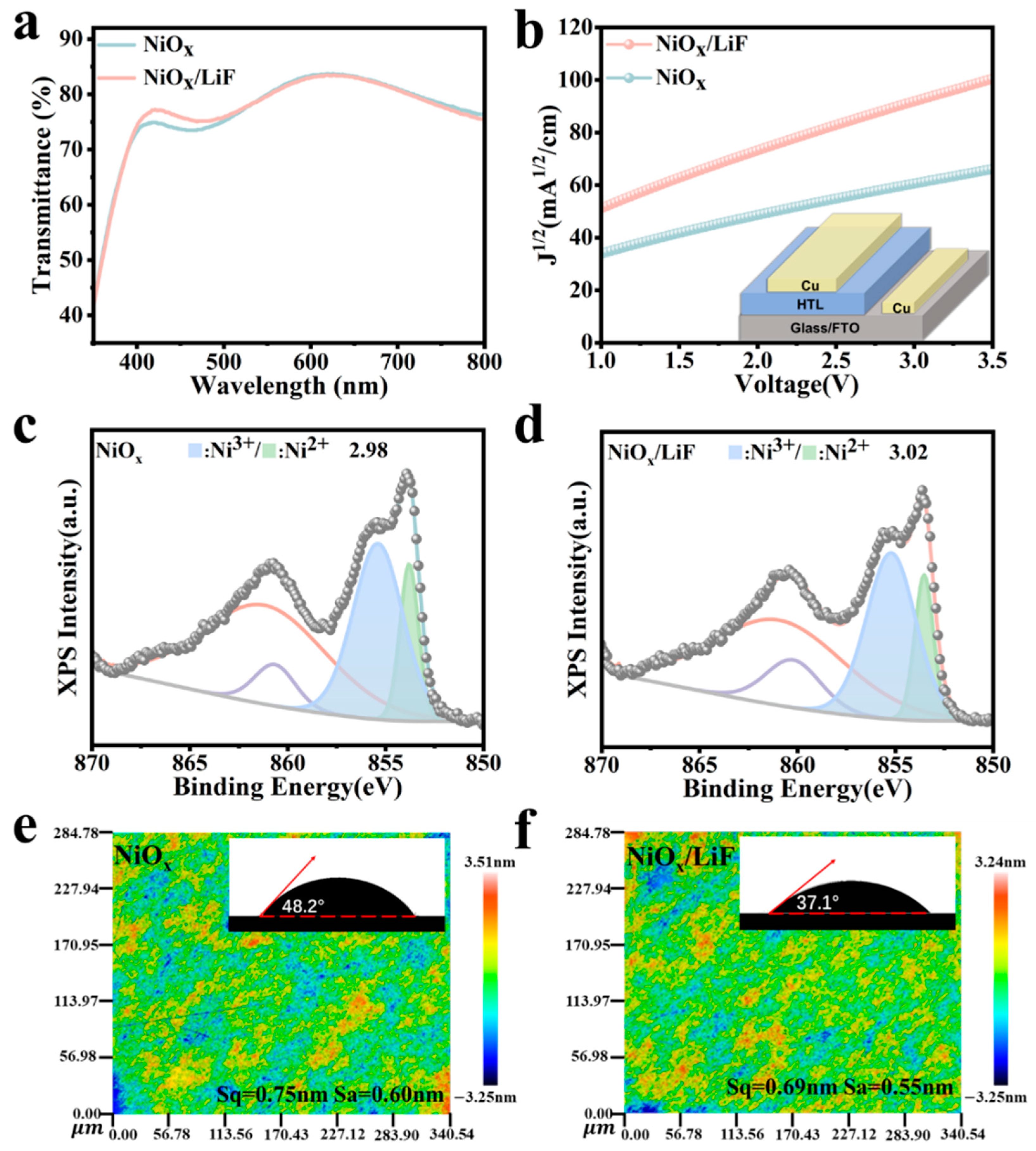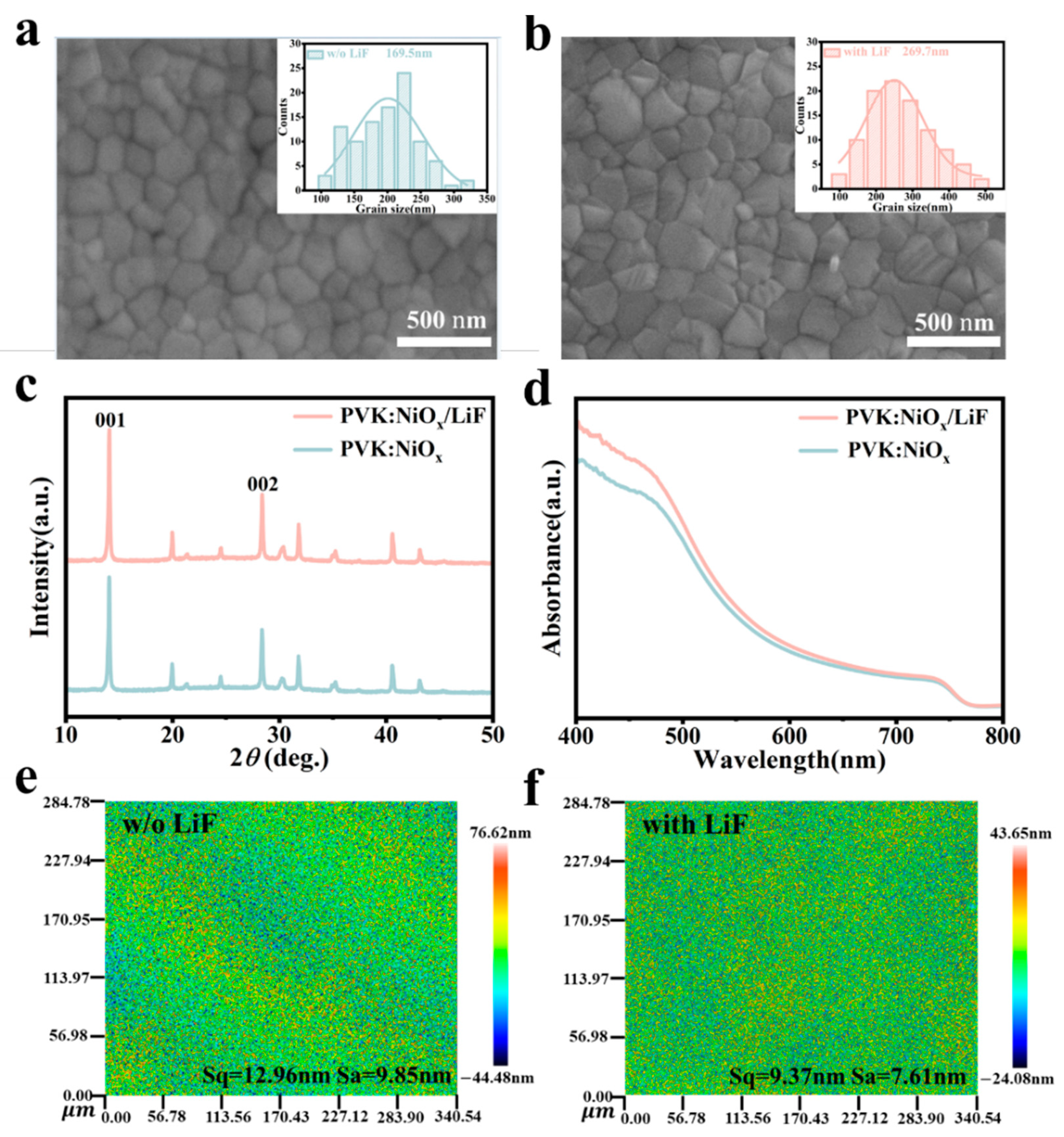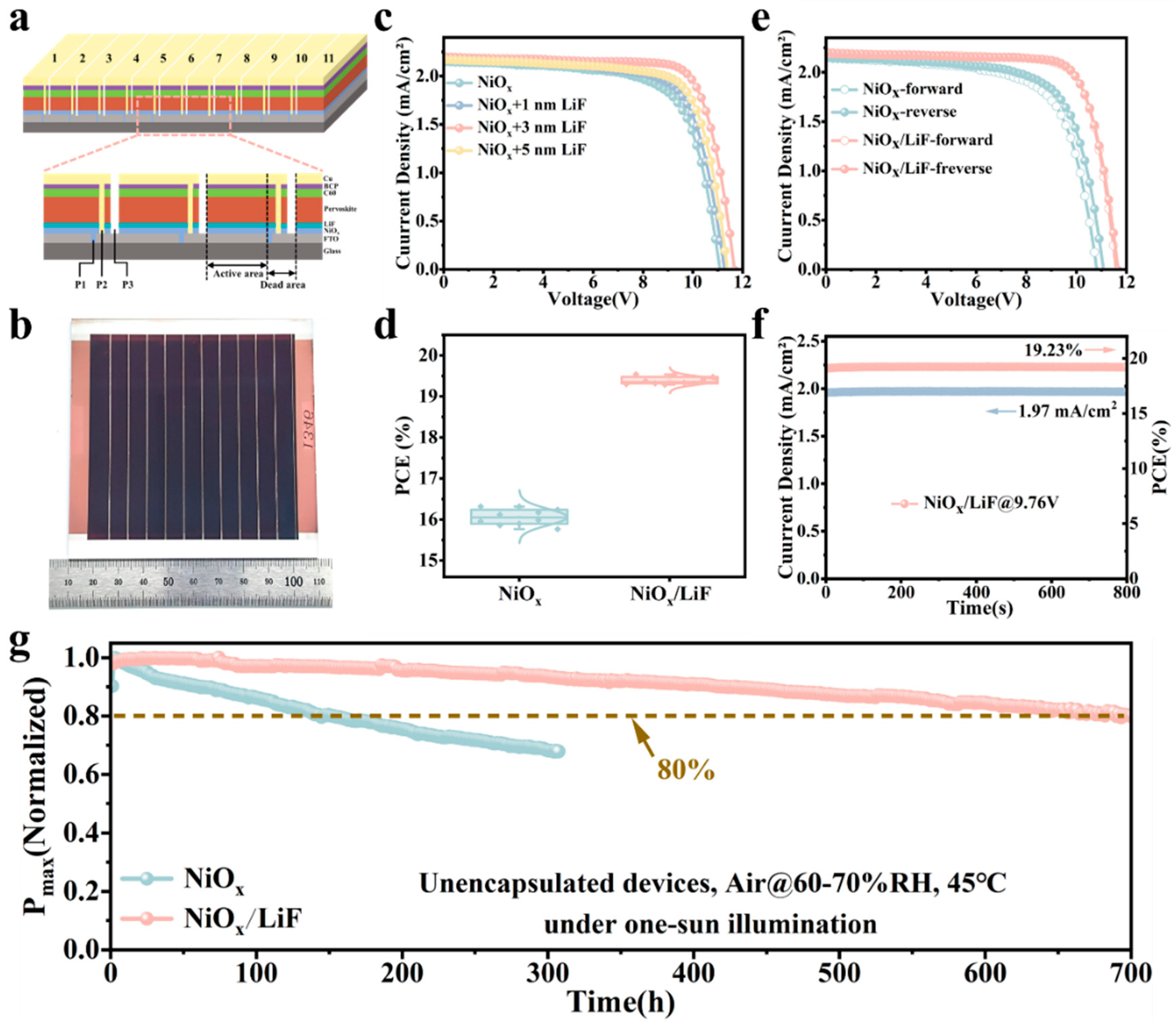Enhancing Conductivity of Nickel Oxide to Achieve Scalable Preparation for High-Efficiency Perovskite Solar Modules
Abstract
1. Introduction
2. Materials and Methods
2.1. Materials
2.2. Device Fabrication
2.3. Characterization
3. Results and Discussion
4. Conclusions
Supplementary Materials
Author Contributions
Funding
Data Availability Statement
Acknowledgments
Conflicts of Interest
References
- Liu, S.; Li, J.; Xiao, W.; Chen, R.; Sun, Z.; Zhang, Y.; Lei, X.; Hu, S.; Kober-Czerny, M.; Wang, J.; et al. Buried interface molecular hybrid for inverted perovskite solar cells. Nature 2024, 632, 536–542. [Google Scholar] [CrossRef] [PubMed]
- Zhao, X.; Zhang, P.; Liu, T.; Tian, B.; Jiang, Y.; Zhang, J.; Tang, Y.; Li, B.; Xue, M.; Zhang, W.; et al. Operationally stable perovskite solar modules enabled by vapor-phase fluoride treatment. Science 2024, 385, 433–438. [Google Scholar] [CrossRef] [PubMed]
- Zhang, Z.; Li, M.; Li, R.; Zhuang, X.; Wang, C.; Shang, X.; He, D.; Chen, J.; Chen, C. Suppressing Ion Migration by Synergistic Engineering of Anion and Cation toward High-Performance Inverted Perovskite Solar Cells and Modules. Adv. Mater. 2024, 36, 2313860. [Google Scholar] [CrossRef] [PubMed]
- Zhumagali, S.; Isikgor, F.H.; Maity, P.; Yin, J.; Ugur, E.; De Bastiani, M.; Subbiah, A.S.; Mirabelli, A.J.; Azmi, R.; Harrison, G.T.; et al. Linked Nickel Oxide/Perovskite Interface Passivation for High-Performance Textured Monolithic Tandem Solar Cells. Adv. Energy Mater. 2021, 11, 2101662. [Google Scholar] [CrossRef]
- Wang, L.; Zhang, T.; Yuan, S.; Qian, F.; Li, X.; Zheng, H.; Huang, J.; Li, S. Over 19% Efficiency Perovskite Solar Modules by Simultaneously Suppressing Cation Deprotonation and Iodide Oxidation. ACS Appl. Mater. Interfaces 2024, 16, 4751–4762. [Google Scholar] [CrossRef]
- Mao, L.; Yang, T.; Zhang, H.; Shi, J.; Hu, Y.; Zeng, P.; Li, F.; Gong, J.; Fang, X.; Sun, Y.; et al. Fully Textured, Production-Line Compatible Monolithic Perovskite/Silicon Tandem Solar Cells Approaching 29% Efficiency. Adv. Mater. 2022, 34, 2206193. [Google Scholar] [CrossRef]
- Wu, Y.; Zheng, P.; Peng, J.; Xu, M.; Chen, Y.; Surve, S.; Lu, T.; Anh Dinh, B.; Li, N.; Liang, W.; et al. 27.6% Perovskite/c-Si Tandem Solar Cells Using Industrial Fabricated TOPCon Device. Adv. Energy Mater. 2022, 12, 2200821. [Google Scholar] [CrossRef]
- Yang, Z.; Zhang, W.; Wu, S.; Zhu, H.; Liu, Z.; Liu, Z.; Jiang, Z.; Chen, R.; Zhou, J.; Lu, Q.; et al. Slot-die coating large-area formamidinium-cesium perovskite film for efficient and stable parallel solar module. Sci. Adv. 2021, 7, eabg3749. [Google Scholar] [CrossRef]
- Zhou, Y.; Huang, X.; Zhang, J.; Zhang, L.; Wu, H.; Zhou, Y.; Wang, Y.; Wang, Y.; Fu, W.; Chen, H. Interfacial Modification of NiOx for Highly Efficient and Stable Inverted Perovskite Solar Cells. Adv. Energy Mater. 2024, 14, 2400616. [Google Scholar] [CrossRef]
- Yu, S.; Xiong, Z.; Zhou, H.; Zhang, Q.; Wang, Z.; Ma, F.; Qu, Z.; Zhao, Y.; Chu, X.; Zhang, X.; et al. Homogenized NiOx nanoparticles for improved hole transport in inverted perovskite solar cells. Science 2023, 382, 1399–1404. [Google Scholar] [CrossRef]
- Chen, W.; Liu, F.Z.; Feng, X.Y.; Djurisic, A.B.; Chan, W.K.; He, Z.B. Cesium Doped NiOx as an Efficient Hole Extraction Layer for Inverted Planar Perovskite Solar Cells. Adv. Energy Mater. 2017, 7, 1700722. [Google Scholar] [CrossRef]
- Yao, K.; Li, F.; He, Q.Q.; Wang, X.F.; Jiang, Y.H.; Huang, H.T.; Jen, A.K.Y. A copper-doped nickel oxide bilayer for enhancing efficiency and stability of hysteresis-free inverted mesoporous perovskite solar cells. Nano Energy 2017, 40, 155–162. [Google Scholar] [CrossRef]
- Sun, X.; Zhang, C.; Gao, D.; Zhang, S.; Li, B.; Gong, J.; Li, S.; Xiao, S.; Zhu, Z.; Li, Z.A. Boosting Efficiency and Stability of NiOx-Based Inverted Perovskite Solar Cells Through D-A Type Semiconductor Interface Modulation. Adv. Funct. Mater. 2024, 34, 2315157. [Google Scholar] [CrossRef]
- Li, B.; Zhang, C.L.; Gao, D.P.; Sun, X.L.; Zhang, S.F.; Li, Z.; Gong, J.Q.; Li, S.; Zhu, Z.L. Suppressing Oxidation at Perovskite-NiOx Interface for Efficient and Stable Tin Perovskite Solar Cells. Adv. Mater. 2024, 36, 2309768. [Google Scholar] [CrossRef]
- Pu, X.; Zhao, J.; Li, Y.; Zhang, Y.; Loi, H.-L.; Wang, T.; Chen, H.; He, X.; Yang, J.; Ma, X.; et al. Stable NiOx-based inverted perovskite solar cells achieved by passivation of multifunctional star polymer. Nano Energy 2023, 112, 108506. [Google Scholar] [CrossRef]
- Li, H.; Zhang, C.; Gong, C.; Zhang, D.; Zhang, H.; Zhuang, Q.; Yu, X.; Gong, S.; Chen, X.; Yang, J.; et al. 2D/3D heterojunction engineering at the buried interface towards high-performance inverted methylammonium-free perovskite solar cells. Nat. Energy 2023, 8, 946–955. [Google Scholar] [CrossRef]
- Cao, Q.; Wang, T.; Pu, X.; He, X.; Xiao, M.; Chen, H.; Zhuang, L.; Wei, Q.; Loi, H.-L.; Guo, P.; et al. Co-Self-Assembled Monolayers Modified NiOx for Stable Inverted Perovskite Solar Cells. Adv. Mater. 2024, 36, 2311970. [Google Scholar] [CrossRef]
- Li, Z.; Sun, X.; Zheng, X.; Li, B.; Gao, D.; Zhang, S.; Wu, X.; Li, S.; Gong, J.; Luther, J.M.; et al. Stabilized hole-selective layer for high-performance inverted p-i-n perovskite solar cells. Science 2023, 382, 284–289. [Google Scholar] [CrossRef]
- Tang, H.; Shen, Z.; Shen, Y.; Yan, G.; Wang, Y.; Han, Q.; Han, L. Reinforcing self-assembly of hole transport molecules for stable inverted perovskite solar cells. Science 2024, 383, 1236–1240. [Google Scholar] [CrossRef]
- Niu, T.; Zhu, W.; Zhang, Y.; Xue, Q.; Jiao, X.; Wang, Z.; Xie, Y.-M.; Li, P.; Chen, R.; Huang, F.; et al. D-A-π-A-D-type Dopant-free Hole Transport Material for Low-Cost, Efficient, and Stable Perovskite Solar Cells. Joule 2021, 5, 249–269. [Google Scholar] [CrossRef]
- Kotta, A.; Seo, I.; Shin, H.-S.; Seo, H.-K. Room-temperature processed hole-transport layer in flexible inverted perovskite solar cell module. Chem. Eng. J. 2022, 435, 134805. [Google Scholar] [CrossRef]
- Wang, L.; Qian, F.; Zhang, T.; Zheng, H.; Li, X.; Lan, T.; Xu, Q.; Zhang, P.; Li, S.J.E.; Science, E. Electrophilic Molecule-Induced π-π Interactions Reduce Energy Disorder of Hole Transport Layer for Highly Efficient Perovskite Solar Modules. Energy Environ. Sci. 2024. [Google Scholar] [CrossRef]
- Jing, P.; Zhou, X.; Xu, Z.; Xu, Z. Numerical and experimental investigation on photothermal performance of polyimide/high-electrical-performance-coating composite films considering surface roughness. J. Therm. Sci. 2022, 31, 1206–1219. [Google Scholar] [CrossRef]
- Bai, Y.; Zhou, Z.; Xue, Q.; Liu, C.; Li, N.; Tang, H.; Zhang, J.; Xia, X.; Zhang, J.; Lu, X.; et al. Dopant-Free Bithiophene-Imide-Based Polymeric Hole-Transporting Materials for Efficient and Stable Perovskite Solar Cells. Adv. Mater. 2022, 34, 2110587. [Google Scholar] [CrossRef] [PubMed]
- Chen, H.; Yang, J.; Cao, Q.; Wang, T.; Pu, X.; He, X.; Chen, X.; Li, X. π-Interactions suppression of buried interface defects for efficient and stable inverted perovskite solar cells. Nano Energy 2023, 117, 108883. [Google Scholar] [CrossRef]
- Wang, H.; Zhang, W.; Wang, B.; Yan, Z.; Chen, C.; Hua, Y.; Wu, T.; Wang, L.; Xu, H.; Cheng, M. Modulating buried interface with multi-fluorine containing organic molecule toward efficient NiOx-based inverted perovskite solar cell. Nano Energy 2023, 111, 108363. [Google Scholar] [CrossRef]
- Cao, F.; Cheng, F.; Huang, X.; Dai, X.; Tang, Z.; Nie, S.; Yin, J.; Li, J.; Zheng, N.; Wu, B. Synergistic Effect between NiOx and P3HT Enabling Efficient and Stable Hole Transport Pathways for Regular Perovskite Photovoltaics. Adv. Funct. Mater. 2022, 32, 2201423. [Google Scholar] [CrossRef]
- Liu, H.; Li, C.; Dong, J.; Dai, Y.; Wang, P.; Shi, B.; Zhao, Y.; Zhang, X. Indium Iodide Additive Realizing Efficient Mixed Sn-Pb Perovskite Solar Cells. Adv. Energy Mater. 2024, 14, 202304234. [Google Scholar] [CrossRef]
- Barua, P.; Hwang, I. Bulk Perovskite Crystal Properties Determined by Heterogeneous Nucleation and Growth. Materials 2023, 16, 29. [Google Scholar] [CrossRef]
- Alghamdi, A.R.M.; Yanagida, M.; Shirai, Y.; Andersson, G.G.; Miyano, K. Surface Passivation of Sputtered NiOx Using a SAM Interface Layer to Enhance the Performance of Perovskite Solar Cells. ACS Omega 2022, 7, 12147–12157. [Google Scholar] [CrossRef]
- Zhang, S.; Ye, F.; Wang, X.; Chen, R.; Zhang, H.; Zhan, L.; Jiang, X.; Li, Y.; Ji, X.; Liu, S.; et al. Minimizing buried interfacial defects for efficient inverted perovskite solar cells. Science 2023, 380, 404–409. [Google Scholar] [CrossRef] [PubMed]
- Zhang, T.; Wang, F.; Chen, H.; Qian, F.; Li, J.; Zheng, H.L.; Yuan, S.H.; Peng, X.F.; Wang, Y.F.; Huang, J.; et al. Synchronized B-site alloying for high-efficiency inorganic tin-lead perovskite solar cells. Appl. Phys. Rev. 2023, 10, 11. [Google Scholar] [CrossRef]
- Cao, Y.; Yan, N.; Wang, M.Z.; Qi, D.Y.; Zhang, J.F.; Chen, X.; Qin, R.; Xiao, F.W.; Zhao, G.T.; Liu, Y.C.; et al. Designed Additive to Regulated Crystallization for High Performance Perovskite Solar Cell. Angew. Chem. Int. Ed. 2024, 9, e202404401. [Google Scholar]
- Li, G.; Su, Z.; Canil, L.; Hughes, D.; Aldamasy, M.H.; Dagar, J.; Trofimov, S.; Wang, L.; Zuo, W.; Jerónimo-Rendon, J.J.; et al. Highly efficient p-i-n perovskite solar cells that endure temperature variations. Science 2023, 379, 399–403. [Google Scholar] [CrossRef] [PubMed]
- Zhai, P.; Ren, L.X.; Zhang, Y.R.; Xu, Z.; Wu, Y.; Zhao, K.; Zhang, L.; Liu, S.Z. Performance-limiting formation kinetics in green water-processed perovskite solar cells. Energy Environ. Science 2023, 16, 3014–3024. [Google Scholar]
- Su, L. Growth of a Sub-Centimeter-Sized CsPbBr3 Bulk Single Crystal Using an Anti-Solvent Precipitation Method. Symmetry 2024, 16, 332. [Google Scholar] [CrossRef]
- Wu, S.Y.; Lin, S.Y.; Shi, Z.Q.; Guo, D.E.; Huang, H.; Zhou, X.F.; Zhang, D.; Zhou, K.C.; Zhang, W.H.; Hu, Y.; et al. Improved Thermal Stability and Film Uniformity of Halide Perovskite by Confinement Effect brought by Polymer Chains of Polyvinyl Pyrrolidone. Small 2023, 19, 11. [Google Scholar] [CrossRef] [PubMed]
- Liu, L.; Ma, Y.; Wang, Y.; Ma, Q.; Wang, Z.; Yang, Z.; Wan, M.; Mahmoudi, T.; Hahn, Y.-B.; Mai, Y. Hole-Transport Management Enables 23%-Efficient and Stable Inverted Perovskite Solar Cells with 84% Fill Factor. Nano-Micro Lett. 2023, 15, 117. [Google Scholar] [CrossRef]
- Jiang, C.; Qin, T.; Tan, L.; Li, H.; Zhou, J.; Li, M.; Dang, Z.-M.; Ding, L.; Xiong, Q.; Yi, C. Revealing the Hole and Electron Transport Dynamics in the Working Devices for Efficient Semitransparent Perovskite Solar Cells. Adv. Energy Mater. 2024, 14, 2304093. [Google Scholar] [CrossRef]
- Seo, J.H.; Kim, H.J.; Cho, S.N. Build-up of symmetry breaking using a titanium suboxide in bulk-heterojunction solar cells. Phys. Chem. Chem. Phys. 2012, 14, 4062–4065. [Google Scholar] [CrossRef]
- Xie, G.; Li, Q.; Lu, X.; Li, L. Tailoring p-Type Charge-Transfer-Doped Hole Transport Layer for All-Inorganic CsPbBr3 Perovskite Solar Cells. ACS Photonics 2024, 11, 3365–3374. [Google Scholar] [CrossRef]
- Tian, H.; Jiang, X.; Liu, X.; Sun, F.; Guo, X.; Li, C. Enhancing performances of inverted perovskite solar cells by modifying the buried interface with sodium copper chlorophyllin. Nano Energy 2024, 126, 109616. [Google Scholar] [CrossRef]
- Yuan, S.H.; Zhang, T.; Chen, H.; Ji, Y.; Hao, Y.H.; Zheng, H.L.; Wang, Y.F.; Chen, Z.D.; Chen, L.; Li, S.B. Dual-functional passivators for highly efficient and hydrophobic FA-based perovskite solar cells. Chem. Eng. J. 2022, 433, 9. [Google Scholar] [CrossRef]
- Zhang, T.; Qian, F.; Chen, H.; Zheng, H.L.; Wang, L.; Yuan, S.H.; Wu, Y.F.; Chen, Z.D.; Li, S.B. Critical role of post-treatment induced surface reconstruction for high performance inorganic tin-lead perovskite solar cells. Chem. Eng. J. 2024, 479, 9. [Google Scholar] [CrossRef]
- Zheng, H.L.; Peng, X.F.; Chen, T.X.; Zhang, T.; Yuan, S.H.; Wang, L.; Qian, F.; Huang, J.; Liu, X.D.; Chen, Z.D.; et al. Boosting efficiency and stability of 2D alternating cation perovskite solar cells via rational surface-modification: Marked passivation efficacy of anion. J. Energy Chem. 2023, 84, 354–362. [Google Scholar] [CrossRef]
- Qiu, J.; Mei, X.; Zhang, M.; Wang, G.; Zou, S.; Wen, L.; Huang, J.; Hua, Y.; Zhang, X. Dipolar Chemical Bridge Induced CsPbI3 Perovskite Solar Cells with 21.86% Efficiency. Angew. Chem. Int. Ed. 2024, 63, e202401751. [Google Scholar] [CrossRef]




Disclaimer/Publisher’s Note: The statements, opinions and data contained in all publications are solely those of the individual author(s) and contributor(s) and not of MDPI and/or the editor(s). MDPI and/or the editor(s) disclaim responsibility for any injury to people or property resulting from any ideas, methods, instructions or products referred to in the content. |
© 2024 by the authors. Licensee MDPI, Basel, Switzerland. This article is an open access article distributed under the terms and conditions of the Creative Commons Attribution (CC BY) license (https://creativecommons.org/licenses/by/4.0/).
Share and Cite
Wang, L.; Li, X.; Yuan, S.; Qian, F.; Kang, Z.; Li, S. Enhancing Conductivity of Nickel Oxide to Achieve Scalable Preparation for High-Efficiency Perovskite Solar Modules. Symmetry 2024, 16, 1357. https://doi.org/10.3390/sym16101357
Wang L, Li X, Yuan S, Qian F, Kang Z, Li S. Enhancing Conductivity of Nickel Oxide to Achieve Scalable Preparation for High-Efficiency Perovskite Solar Modules. Symmetry. 2024; 16(10):1357. https://doi.org/10.3390/sym16101357
Chicago/Turabian StyleWang, Lei, Xiaobo Li, Shihao Yuan, Feng Qian, Zhangli Kang, and Shibin Li. 2024. "Enhancing Conductivity of Nickel Oxide to Achieve Scalable Preparation for High-Efficiency Perovskite Solar Modules" Symmetry 16, no. 10: 1357. https://doi.org/10.3390/sym16101357
APA StyleWang, L., Li, X., Yuan, S., Qian, F., Kang, Z., & Li, S. (2024). Enhancing Conductivity of Nickel Oxide to Achieve Scalable Preparation for High-Efficiency Perovskite Solar Modules. Symmetry, 16(10), 1357. https://doi.org/10.3390/sym16101357





